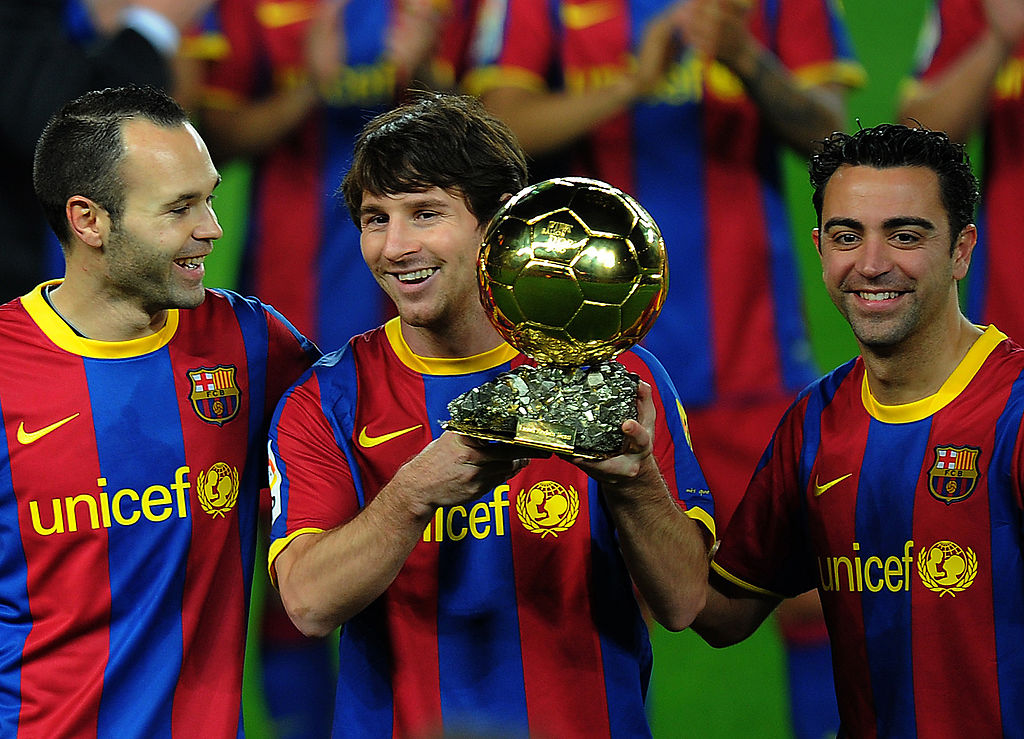High-flier to low-rider: What's the problem with Benteke?
Paul Wilkes ponders the Belgian's unfair transition from flier to flop in the space of just six months...
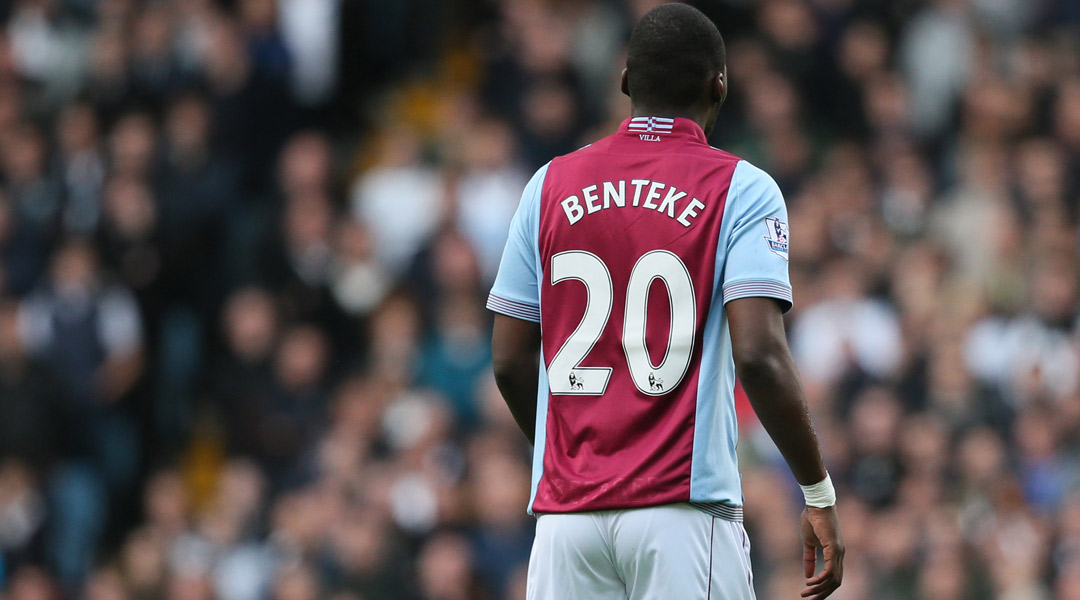
The last time Aston Villa travelled to Anfield, Christian Benteke was a man on fire. The Belgian was unplayable as Liverpool's centre-back partnership of Martin Skrtel and Daniel Agger failed to deal with his brute strength.
It brought him to the forefront of supporters' minds and drew admiring glances from rival clubs - namely Tottenham, Chelsea and Arsenal - who would keep tabs on the forward for the rest of the campaign and through the summer transfer window.
What's often forgotten is that his career at the club took a couple of months to take off. Benteke scored on his debut against Swansea after appearing as a second-half substitute, then netted just two goals in his next 13 league starts. With Darren Bent initially preferred, it was the young Belgian's physical characteristics that pushed him ahead of the former Sunderland poacher, now on loan at Fulham.
Unfavourable comparisons were made with Emile Heskey, with many fans struggling to understand Paul Lambert's reasoning for spending so much on a striker when a huge amount had relatively recently been spent to acquire Bent, albeit by a different manager.
Get FourFourTwo Newsletter
The best features, fun and footballing quizzes, straight to your inbox every week.
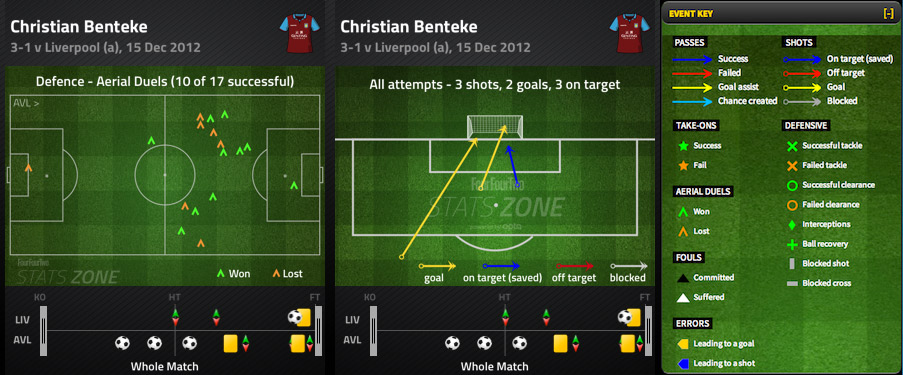
But the game against Liverpool seemed to make sense of it all, even if it said as much about the Reds' abilities to deal with a physical and imposing striker as it did about Benteke. Villa had half the number of shots, less possession (28%) and made fewer passes with a meagre 69% completion rate. Their direct and fast counter-attacking football was beginning to take form. Lambert's team were not about controlling the ball, but dictating the space by keeping their shape and surprising the opposition with pace and power. Benteke embodied it.
Against the top eight sides, and on their travels, Villa can prove effective. They habitually retain the ball less, but are usually attacking a high-line, thus allowing their forwards room to run into. At Villa Park they've faced their biggest obstacles, with teams sitting deeper and allowing the claret-and-blue outfit to dictate the tempo. Only Crystal Palace can bemoan a lower possession average this season, and no side in the Premier League plays more long balls per game. As a number of teams further down the league have better resources for coping with that aerial threat, it's no surprise they have the second-worst home record in the top flight.
Last summer the aforementioned big guns made advances for Benteke, with figures in excess of £25 million bandied about. When it looked like the Belgian would up sticks after just a season, Villa produced a new contract despite the Belgian having three years remaining on his current deal.
But this was not the root cause of his issues; this season, before picking up an injury in mid-September he'd scored five goals in all competitions. "He's a young guy and his confidence suffers, as everyone else's does," stated Lambert at the turn of the year.
That was no more apparent when, through on goal against Sunderland after turning the defender with a clever drag-back, his curled effort was cleared off the line. You could sense the dejection as he lowered his body, so much so that when the ball fell back to him unexpectedly six seconds later he took a wild swing and missed it completely.
Plenty had been made about Benteke's 11-game goal drought before breaking his duck against Arsenal on Monday. After all, he'd hit 17 in 19 games before that. However, the 23-year-old endured two injuries in that period, completing 90 minutes in only six of those matches. When Benteke doesn't play, his team-mates have to find other ways of breaking down defences, and without much creativity in midfield this has proven difficult. When he returns to action they are quick to revert to route one, and quickly become over-reliant on it.
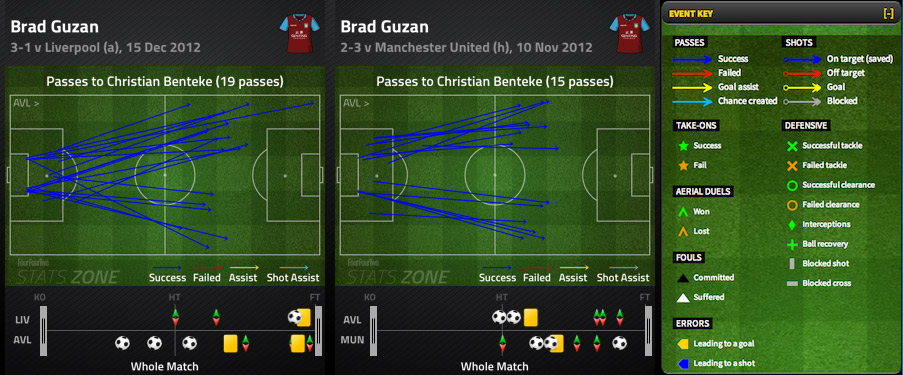
Goalkeeper Brad Guzan made 19 passes to Benteke in last season's Liverpool clash. The next-highest pass combination tallied nine: Benteke to Andreas Weimann. Of the 17 away games that Benteke did start last season, the Guzan to Benteke routine was top of the passing charts six times, along with home matches against Manchester United and Tottenham.
This season's difficult opening away games at the Emirates Stadium and Stamford Bridge started in the same manner, with Guzan and Benteke combining once more. The striker scored four goals in the season's first four matches. Against Arsenal on Monday night it was Villa's most prolific passing route again - and Benteke was back among the goals.
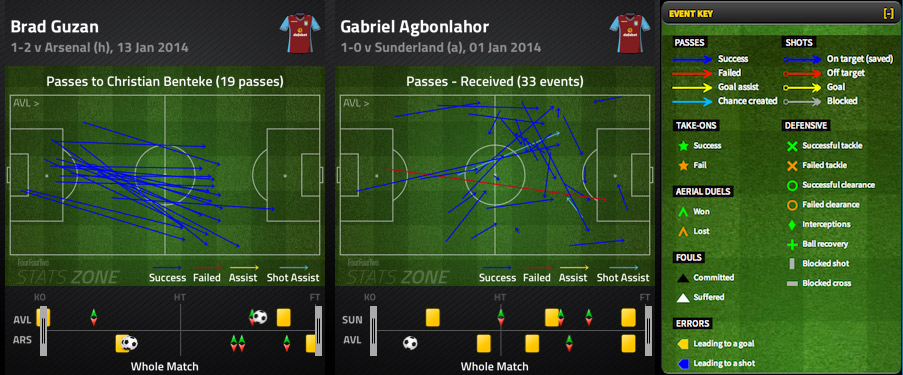
Rarely do Villa score directly from this approach, but it's the sequence of events that disrupts the team they are facing. When Guzan punts the ball out to the wings, Benteke makes a reverse run towards that area. The majority of full-backs are unable to deal with his presence and should the centre-back closest to him track the run, he will often mistime the challenge and concede a free-kick, or not be quick enough to intercept the ball. When the central defender goes with Benteke, it invariably leaves a gap at the back for midfield runners to expose, or for the wingers to cut inside as he flicks it on.
Gabriel Agbonlahor is the greatest exposer of this situation. The Birmingham-born forward doesn't always use his lightning pace to good effect, but his link-up play with Benteke is often excellent and together they are Villa's most dangerous weapon. The combination of muscle and speed causes opposing defences problems. Last season Benteke netted just four of his 19 goals when his strike partner was not on the pitch.
Matthew Lowton's superb delivery for Benteke's goal against Arsenal proved that Villa must do more to provide him with similar quality - no team attempts fewer crosses than the West Midlands side. In Lambert's sole top-flight season with Norwich, the Canaries were sixth in this respect.
Lambert is a reactive manager who tends to pick his formations dependent on who his team are playing, but the 4-3-3 structure does seem to suit Benteke the best. The attacking trio of the burly Belgian, Agbonlahor and Weimann offers the best balance at present.
The perception of Benteke is probably his biggest quandary. He isn't the next Didier Drogba, nor is he the next Savo Milosevic. At 23 years old he has plenty of time to fulfil his talent and take advantage of that incredible physique. Used properly he can still be devastating.
